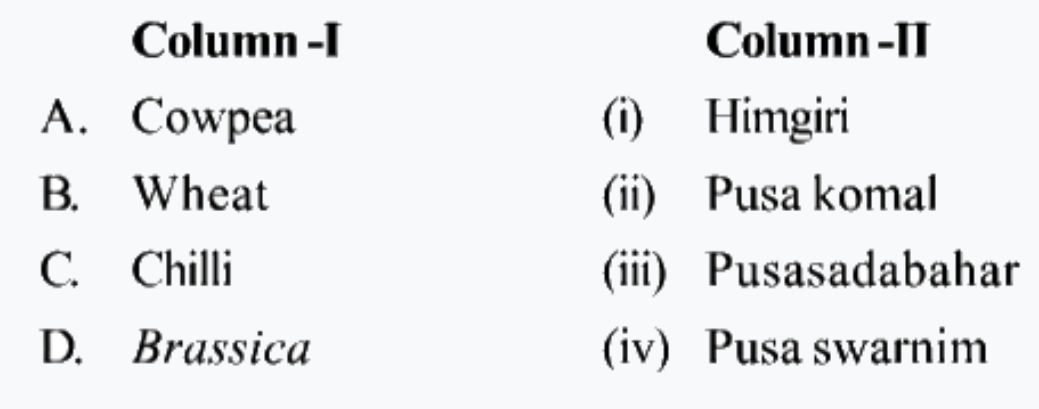Match column I with column II an select the correct option from the codes given below.
Column IColumn IIA. Carbomino-heamoglobin(i) InspirationB. Diaphragm(ii) Hamburger's phenomenonC. Larynx(iii) Diffusion of Cl−into RBC D. Pons varolii(iv) Carbon dioxideE. Chloride shift(v) Cartilages(vi) Pneumotaxic centre(vii) Expiration
a) A−(iv),B−(i),(vii),C−(v),D−(vi),E−(ii),(iii)
b) A−(v),B−(i),C−(iv),(vii),D−(vi),E−(ii),(iii)
c) A−(ii),(vi),B−(i),C−(iii),D−(v),(vii),E−(iv)
d) A−(iii),B−(i),C−(ii),(v),D−(vi),(vii),E−(iv)
The correct Answer is:A
To solve the matching question, we will analyze each item in Column I and find the appropriate match in Column II.
1. A. Hemoglobin:
- Hemoglobin is a protein in red blood cells that binds to carbon dioxide. The term "Carbomino-" refers to the compound formed when carbon dioxide binds to hemoglobin.
- Match: (iv) Carbon dioxide.
2. B. Diaphragm:
- The diaphragm is a muscle that plays a crucial role in the process of breathing. When it contracts, it causes inspiration (inhalation) by increasing the volume of the thoracic cavity.
- Match: (i) Inspiration.
3. C. Larynx:
- The larynx is an organ located in the throat that contains the vocal cords. It is also involved in the passage of air and protects the trachea against food aspiration.
- Match: (v) Cartilages.
4. D. Pons Varolii:
- The pons is part of the brainstem and contains the pneumotaxic center, which regulates the rhythm of breathing by inhibiting inspiration.
- Match: (vi) Pneumotaxic centre.
5. E. Chloride shift:
- The chloride shift refers to the process where bicarbonate ions (HCO3-) move out of red blood cells (RBCs) and chloride ions (Cl-) move in to maintain electrical neutrality. This process occurs in the context of gas exchange in the blood.
- Match: (ii) Hamburger's phenomenon.
Final Matches:
- A - (iv) Carbon dioxide
- B - (i) Inspiration
- C - (v) Cartilages
- D - (vi) Pneumotaxic centre
- E - (ii) Hamburger's phenomenon
Correct Option Code:
The correct option code based on the matches is:
- A - iv
- B - i
- C - v
- D - vi
- E - ii
- Hemoglobin is a protein in red blood cells that binds to carbon dioxide. The term "Carbomino-" refers to the compound formed when carbon dioxide binds to hemoglobin.
- Match: (iv) Carbon dioxide.
- The diaphragm is a muscle that plays a crucial role in the process of breathing. When it contracts, it causes inspiration (inhalation) by increasing the volume of the thoracic cavity.
- Match: (i) Inspiration.
- The larynx is an organ located in the throat that contains the vocal cords. It is also involved in the passage of air and protects the trachea against food aspiration.
- Match: (v) Cartilages.
- The pons is part of the brainstem and contains the pneumotaxic center, which regulates the rhythm of breathing by inhibiting inspiration.
- Match: (vi) Pneumotaxic centre.
- The chloride shift refers to the process where bicarbonate ions (HCO3-) move out of red blood cells (RBCs) and chloride ions (Cl-) move in to maintain electrical neutrality. This process occurs in the context of gas exchange in the blood.
- Match: (ii) Hamburger's phenomenon.
- A - (iv) Carbon dioxide
- B - (i) Inspiration
- C - (v) Cartilages
- D - (vi) Pneumotaxic centre
- E - (ii) Hamburger's phenomenon
The correct option code based on the matches is:
- A - iv
- B - i
- C - v
- D - vi
- E - ii
Topper's Solved these Questions
- BREATHING AND EXCHANGE OF GASESBOOK - NCERT FINGERTPS ENGLISHCHAPTER - BREATHING AND EXCHANGE OF GASESEXERCISE - Higher Order Thinking
12 Videos
- BREATHING AND EXCHANGE OF GASESBOOK - NCERT FINGERTPS ENGLISHCHAPTER - BREATHING AND EXCHANGE OF GASESEXERCISE - Exemplar Problems
13 Videos
- BODY FLUIDS AND CIRCULATIONBOOK - NCERT FINGERTPS ENGLISHCHAPTER - BODY FLUIDS AND CIRCULATIONEXERCISE - Body Fluids And Circulation
151 Videos
- CELL - THE UNIT OF LIFEBOOK - NCERT FINGERTPS ENGLISHCHAPTER - CELL - THE UNIT OF LIFEEXERCISE - Cell - The Unit Of Life
159 Videos
Similar Questions
Knowledge Check
Match column I with column II and select the correct option from the codes given below.
 A(i)-D, (ii)-C, (iii)-A, (iv)-BB(i)-A, (ii)-B, (iii)-C, (iv)-DC(i)-D, (ii)-B, (iii)-A, (iv)-CD(i)-A, (ii)-C, (iii)-D, (iv)-B
A(i)-D, (ii)-C, (iii)-A, (iv)-BB(i)-A, (ii)-B, (iii)-C, (iv)-DC(i)-D, (ii)-B, (iii)-A, (iv)-CD(i)-A, (ii)-C, (iii)-D, (iv)-BMatch columnI with column II and select the correct option from the codes given below.
 AA−(iv),B−(iii),C−(v),D−(ii),E−(i)BA−(i),B−(iii),C−(iv),D−(ii),E−(v)CA−(iv),B−(iii),C−(i),D−(ii),E−(v)DA−(v),B−(iv),C−(iii),D−(ii),E−(i)
AA−(iv),B−(iii),C−(v),D−(ii),E−(i)BA−(i),B−(iii),C−(iv),D−(ii),E−(v)CA−(iv),B−(iii),C−(i),D−(ii),E−(v)DA−(v),B−(iv),C−(iii),D−(ii),E−(i)Match column I with column II and select the correct option from the codes given below.
 AA-(i), B-(ii), C-(iii)BA-(iii), B-(i), C-(ii)CA-(iii), B-(ii), C-(i)DA-(ii), B-(i), C-(iii)
AA-(i), B-(ii), C-(iii)BA-(iii), B-(i), C-(ii)CA-(iii), B-(ii), C-(i)DA-(ii), B-(i), C-(iii)
Match Column I with column II and select the correct option from the codes given below:

View SolutionMatch Column I with column II and select the correct option from the codes given below:

View SolutionMatch column-I with column-II and select the correct option from the codes given below :

View SolutionMatch column I with column II and select the correct option from the codes given below.

View SolutionMatch column I with column II and select the correct option from the codes given below.

View Solution

